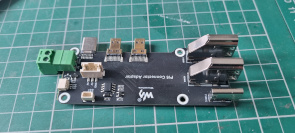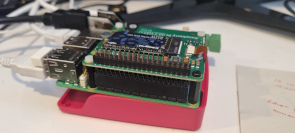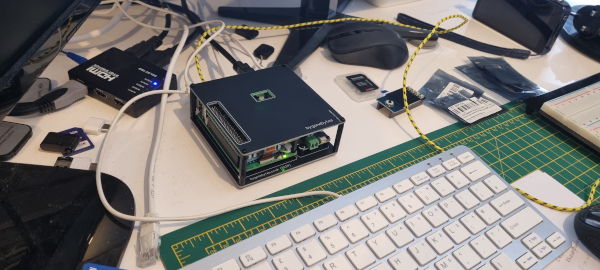I received a 'New Products' email from Pi Hut and the Waveshare Multifunction Adapter caught my eye. This adapter brings out the HDMI and USB type C ports on the same edge as the Ethernet and other USB ports, along with a new case this could make a nice little computer.
I ordered the part and started to look at a case design. My thoughts turned to my Electron clone case which I think will be a good starting place.

I couldn't complete the design until the adapter arrived for a final check on dimensions.
I started to remove the Pi5 from the original Raspberry Pi case which revealed that the GPIO extension supplied with the M.2 Hat was a bit short if I wanted to use the port for anything else so I'm going to replace it with a longer one.




The adapter board arrive and it looks good plugged in, all the cables coming out one end.


and the GPIO extender replaced.

Back to the case and the design is taking on a familiar look.


The Pi5 is now waiting for the case and pillars to arrive.

The base and lid.


The case arrived..looking good then I noticed the job number was printed on top. I'll need to live with it for the moment. (I'm sure I requested it to be removed but the file details say no!)

At least all the mounting holes are in the correct place. I mounted the RPI5 board on 6mm pillars and the Multi Adapter on 8mm pillars. The pillars for the top are 41mm.


Lid on and all these holes are in the correct position.


Sitting back on the desk and it all plugs together nicely.

Look through the case I noticed that there was a fair sized gap between the top of the Pi and the lid so I reduced the pillars to 38mm. It looks a bit better but I think I could reduce the height by a further 2mm.


Sticking some silicon pads on the bottom so it does not slip around the desk.

The Pi looking good on the desk.

And sitting beside the Electron Clone - it looks so small.

and to finish off I replaced my old PC keyboard with the Raspberry Pi keyboard. A perfect match for the Pi5, it gives it the nice feel of the Pi400.



There's a sneek peek at my next project in a few of the photos above. My intention was to connect an I2C thermometer board to the Electron but I got sidetracked when the Raspberry Pi Pico 2 launched. So instead of using my Electron I am using a Pico 1 (until the Pico 2 arrives) and attached the thermometer to that then I extended that to include humidity and pressure sensors and a battery backed Real Time Clock (RTC). When the Pico 2 arrives I'll transfer the code and add a display.